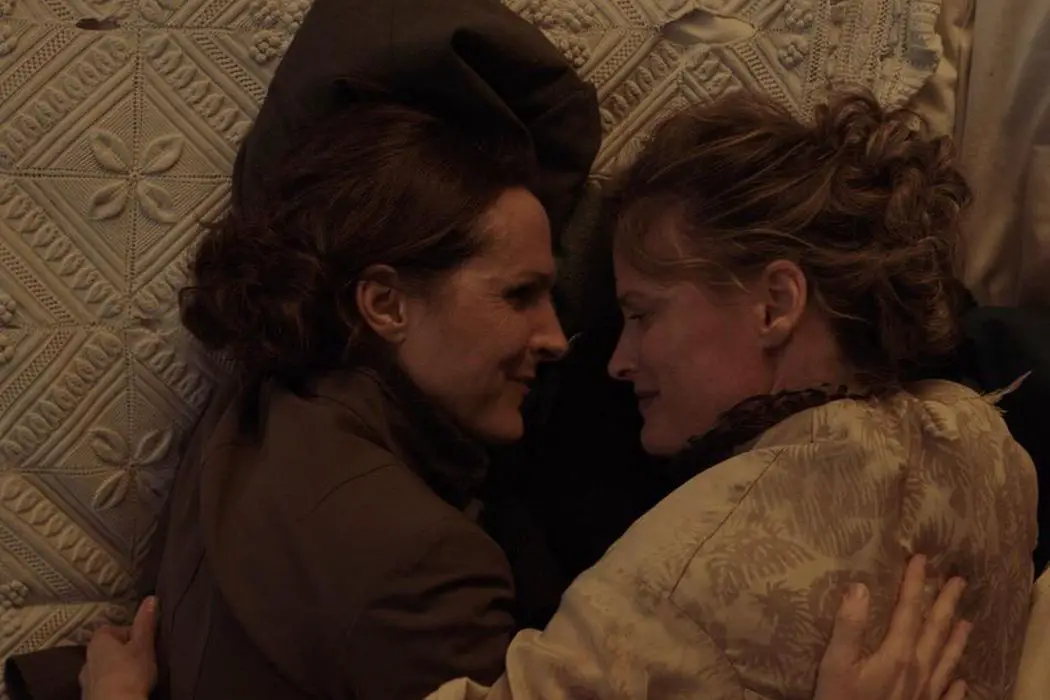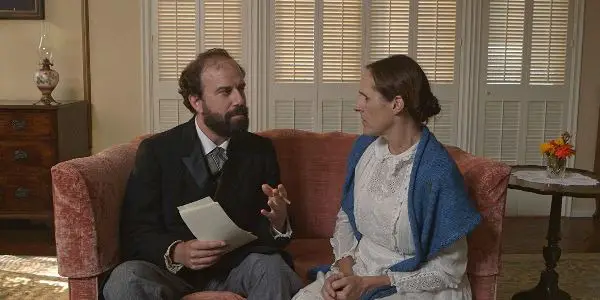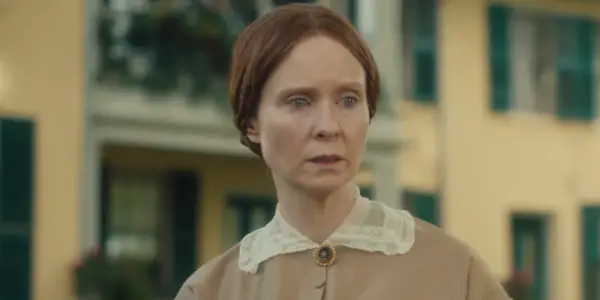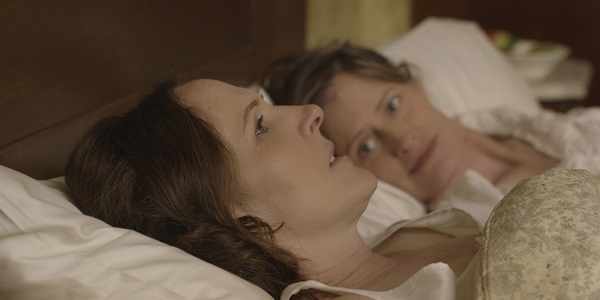The Impossible Fidelity Of Emily Dickinson’s Biopics

Alex is a film addict, TV aficionado, and book lover.…
It’s a well-known fact that biopics get a fair amount of pushback. Some people groan about their frequency, others their lack of style, and, of course, the ever-present question of accuracy. With all these easy to pick faults, making a biopic can be like walking into a minefield, one that few get out of alive.
And yet this doesn’t explain why the poet Emily Dickinson went so long without getting the big screen treatment. The answer is not really that eventful: she’s remembered as a recluse, a spinster, a lonely woman writing away unrecognized and with no great motivation or conflict. Every biopic needs a story, and there simply isn’t a story to the mythology of Dickinson. Strange, then, that the last few years suddenly brought two great biopics of her, and even odder that their portraits cannot possibly be reconciled.
Terence Davies’ A Quiet Passion came first, sticking largely to the established characterization but finding great verve and heartache in her small life. Wild Nights with Emily is a bit more, well, wild. Madeleine Olnek spins a tale of soap opera level intrigue, with Dickinson engaging in a long-term relationship with her brother’s wife that is all but obliterated from the historical record by her brother’s mistress.
These films tell the story of two vastly different people, and yet both share the Dickinson name. Viewers would naturally ask which is the truth, but unlike the question of why it took so long to get a biopic of Dickinson, the answer to which film got it right is much more elusive.
What’s In A Biopic
It is perhaps important to take a step back and examine biopics more broadly, especially since you may have a set idea of one in your head. In actuality, there’s an array of approaches a filmmaker can take, and while their choice can greatly affect one’s expectations for fidelity, none of them are really about capturing the entire person.
There’s always the traditional telling of a person’s life, most often spanning from teenage or young adult into old age. Long, occasionally unwieldy, but often providing excellent showcases for an actor’s range, movies like Raging Bull and La Vie en Rose would be prime examples. With the goal being a general overview of the person’s life, one would expect these to stick to the truth for big events, but the details almost always get streamlined in order to form a story.

Others focus on a single event or accomplishment, like the final months of the 16th President’s life in Lincoln and the women’s time as NASA mathematicians in Hidden Figures. In these, the people themselves are often simplified, allowing their achievements to take center stage. After all, you’re only seeing a tiny slice of their life, so their backstory and many of their characteristics are kind of irrelevant.
Then you have the most loosey-goosey of biopics, ones that are more interested in capturing some strange quality of the person instead of their whole. These may not even initially strike you as biopics; I’m Not There uses six different characters and storylines to explore Bob Dylan’s eclectic career, but the film is irrevocably about Dylan. Or how about the modern masterpiece The Assassination of Jesse James by the Coward Robert Ford, which is so engrossed by the phenomenon of fame that the people in the story are as swept up as we are. These films are not really about the historical events, but they are about truths, and there’s a tacit agreement that biopics with such obvious creative intrusions aren’t to be criticized much for their lack of accuracy.
People love to wring their hands over whether historical figures are getting a fair shake in cinema, and yet we all accept a certain amount of twisting, no matter the approach. That is because, whether consciously or not, few of us ask for historical truth from cinema.
Lincoln punctuates the President’s death with the famous quote from Edwin M. Stanton: “Now he belongs to the ages.” Steven Spielberg didn’t include this for simple historical accuracy; he understands the role of cinema, has shaped it as much as anyone, and he knows that a biopic is little more than a piece of a person’s mythology. Once we are gone (or perhaps even before), the culture decides what is worth remembering about us, and the rest fades away. The fair shake most of us are looking for in a biopic is a representation of what we admire about that person. This is what we need to be asking of the two Dickinson biopics: whether their disparate portraits capture something about the poet that’s worth remembering.
Davies’ Preoccupations Invade A Quiet Passion
Terence Davies seems destined to be a filmmaker that never got his due. While renowned among cinephiles, the average person has probably never heard of him, and the industry itself isn’t exactly chomping at the bit to fund his solemn, thoughtful films. His early work, Distant Voices, Still Lives and The Long Day Closes, capture his memories of ‘40s and ‘50s Britain. Others like The House of Mirth and Sunset Song are about the confines of society, while his documentary Of Time and the City is a meditation on impermanence. What ties them all together is Davies’ incredibly personal touch, as he’s a filmmaker seemingly unable to get out of his own forlorn head. It’s unsurprising, then, that he plucked the parts of Dickinson’s mythology that closely mirror his own persona, and from this he crafted a quintessentially Davies character.

If you read anything about the making of A Quiet Passion, you’ll find that everyone immediately fesses up to the manipulation of truth. Relationships are fudged, events are moved around, and a pretty important character is entirely created. A life story of Dickinson it is not, nor is it a great totem to the poetry she created. This is a theme movie, one where Davies latches on to her complicated religious beliefs and discomfort with the world to show the great connection she still had to it.
Like so many of Davies characters, she is swept up by time, and she observes the goings-on of her life with a longing for things beyond her reach. Davies himself grew up a devout catholic, seemingly never reconciled these beliefs with being a gay man, and admits to feeling perpetually uncomfortable with the cards he was dealt in life. His own inability to connect can be found in so many of his characters, but Dickinson is the one that also captures his hope in art, in its haven of controlled communication, and in its ability to be understood centuries after the artist is gone. In taking on Dickinson, he captured a truth about the way art can be a solace, particularly to those who feel misunderstood, but was that Dickinson’s truth?
Wild Nights With Emily Rights A Wrong
With Davies building on the popular mythology of Dickinson as a lonely spinster, there was little indication to the world at large that there was any other version of her story. However, a debate over her relationship with Susan Gilbert (the wife of Emily’s brother) had long been brewing among Dickinson scholars, one that Madeleine Olnek felt was essential to get out into the world.
Gilbert, it seems, was in frequent correspondence with Dickinson throughout their lives, and curiously many of these letters have been altered. This fact hasn’t gone unnoticed; The New York Times wrote about it in 1998, and it was from this article that Olnek began exploring further the work of scholar Martha Nell Smith and others who assert that Susan and Emily were a romantic pair.
Wild Nights is, essentially, the most straightforward kind of biopic. It tells of Dickinson’s relationship with Susan, of the pivotal people in her literary career, and how her personality was off-putting to the men who controlled the literary establishment. The only way to question its value would be to dismantle its version of Emily’s life, and there’s simply too much in the historical record to claim it’s false (Olnek put together a packet on her research after festival reviewers questioned its veracity).

Olnek seized upon the injustice of the popular Dickinson mythology to make a statement on queer erasure, forming Wild Nights with Emily into a bighearted take on Dickinson’s romantic life and throwing more than a little shade on the people who altered her story. The movie completely reframes Emily as a person who constantly reached out only to have her hand batted away. She wanted to be published, she wanted to be with Susan, and she did her best to get all of it.
The Inescapable Truth
So did either A Quiet Passion or Wild Nights with Emily hit on something worth remembering about Emily Dickinson? They both certainly found something moving and meaningful to explore, but in building off the reclusive spinster version of the poet, Passion is also tacitly promoting a version of the queer, female artist that the world is comfortable with: one that works diligently, doesn’t ask for attention, and can be appreciated without confronting who they actually are.
The erasure of Susan from Emily’s life (and, hence, the interpretation of her work), was no accident. Dickinson went unrecognized in her time because her approach and her views were so unique. Convincing others to take these seriously, particularly as a woman, was too difficult for her to overcome. History has shown that art is easier to digest if the work is divorced from such a radical author, and so her life was edited, removing things could make her difficult to understand for the average person.
What was left, essentially, was a cipher. A reader can put nearly any thoughts and feelings onto a silent person who never leaves their room. This version of her makes her as dead as Roland Barthes could ever hope an author to be, and if it doesn’t chill you to think that her poetry could only be appreciated by killing the intelligent, vivacious, queer woman she was, then you and I are very different people.
A Quiet Passion is, of course, nowhere near as cruel to Dickinson as all that. It does see Dickinson as a person, but it ends up being a person that she was not. Wild Nights is the one trumpeting her views and what she stood for, not a false myth created entirely for other people’s comfort.
What are your thoughts on either of these films about Emily Dickinson?
Does content like this matter to you?
Become a Member and support film journalism. Unlock access to all of Film Inquiry`s great articles. Join a community of like-minded readers who are passionate about cinema - get access to our private members Network, give back to independent filmmakers, and more.
Alex is a film addict, TV aficionado, and book lover. He's perfecting his cat dad energy.













